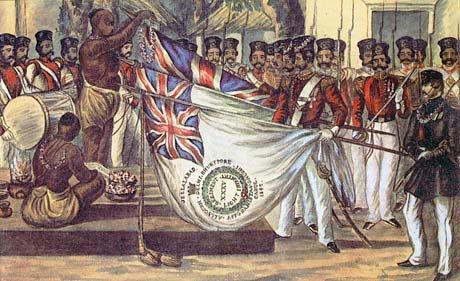It's complicated. Varied over time and in the early days there may have been differences across the three presidencies as they were effectively independent of each other. What period are you interested in?
For example: Early on in the Madras army every Sepoy
company had its own colour (their roots as mercenary bands meant that until the 1760s they were organised as independent companies rather than battalions and they seem to have continued this practice for a while after being reorganised into battalions).
Towards the end of the 18th Century Sepoy battalions of the Bengal Presidency had
three colours: A Union flag, a white flag bearing the East India Company's arms, and one in the regimental facing colour (the latter two both bearing a small Union in the top corner).
European regiments seem to have followed British Army practice of two colours: A King's/Queen's colour and a Regimental colour.
As this picture shows...

...Bengal Native Infantry regiments were still carrying three sets of colours in the 1840s. I
think this was standard practice across all three armies, but I'm not sure. My reference books go into sleep-inducing detail about facing colours and uniforms and shit, but are infuriatingly terse on the subject of colours.
Once the HEIC was nationalised after the Mutiny, Company European regiments were absorbed into the British Army and given new names, and the Sepoy regiments of what was now the Indian Army reverted to a British Army style two-colour system.